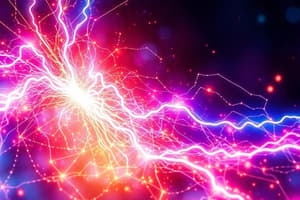Podcast
Questions and Answers
Which of the following non-metals has a charge of 2-?
Which of the following non-metals has a charge of 2-?
- SO4 (correct)
- Cl
- O (correct)
- Br
Sodium (Na) is a non-metal.
Sodium (Na) is a non-metal.
False (B)
What charge does calcium (Ca) typically have in ionic compounds?
What charge does calcium (Ca) typically have in ionic compounds?
2+
The formula for the ammonium ion is ______.
The formula for the ammonium ion is ______.
Match the following metals with their typical charges:
Match the following metals with their typical charges:
What is a physical state of substances that has a high melting and boiling point?
What is a physical state of substances that has a high melting and boiling point?
Sodium chloride can conduct electricity when it is solid.
Sodium chloride can conduct electricity when it is solid.
Why are metals generally considered to be good conductors of electricity?
Why are metals generally considered to be good conductors of electricity?
Sodium chloride has __________ solubility in water.
Sodium chloride has __________ solubility in water.
Match the following substances with their respective solubility in non-polar solvents:
Match the following substances with their respective solubility in non-polar solvents:
Which of the following compounds will only conduct electricity when molten or in aqueous solution?
Which of the following compounds will only conduct electricity when molten or in aqueous solution?
Aluminium bronze has lower resistance to corrosion than pure copper.
Aluminium bronze has lower resistance to corrosion than pure copper.
What allows metals to be ductile?
What allows metals to be ductile?
What type of bond involves the transfer of electrons from metal to non-metal?
What type of bond involves the transfer of electrons from metal to non-metal?
Covalent compounds generally have high melting and boiling points.
Covalent compounds generally have high melting and boiling points.
What is formed when substances combine with oxygen?
What is formed when substances combine with oxygen?
Ionic compounds are solid at room temperature and have _____ melting and boiling points.
Ionic compounds are solid at room temperature and have _____ melting and boiling points.
Match the following properties with the correct type of bond:
Match the following properties with the correct type of bond:
Which of the following describes the structure of ionic compounds?
Which of the following describes the structure of ionic compounds?
Ionic compounds can conduct electricity in their solid state.
Ionic compounds can conduct electricity in their solid state.
What are the weak forces of attraction between molecules in covalent compounds called?
What are the weak forces of attraction between molecules in covalent compounds called?
Ionic compounds are usually soluble in water unless they _____ with the water.
Ionic compounds are usually soluble in water unless they _____ with the water.
Which of the following compounds contains calcium?
Which of the following compounds contains calcium?
Only non-metal atoms can form covalent bonds.
Only non-metal atoms can form covalent bonds.
What is the electron structure of hydrogen?
What is the electron structure of hydrogen?
In a fluorine molecule (F2), two fluorine atoms share __________ electrons.
In a fluorine molecule (F2), two fluorine atoms share __________ electrons.
Match the following chemical compounds with their formula:
Match the following chemical compounds with their formula:
What is the main characteristic of covalent bonds?
What is the main characteristic of covalent bonds?
In a covalent bond, atoms are held together by the attraction of electrons to their nuclei.
In a covalent bond, atoms are held together by the attraction of electrons to their nuclei.
How many outer electrons are in a fluorine atom?
How many outer electrons are in a fluorine atom?
What is the main purpose of the tests described in the document?
What is the main purpose of the tests described in the document?
The appearance of substances can provide information about the arrangement of their particles.
The appearance of substances can provide information about the arrangement of their particles.
What suggestion is made regarding the melting points of substances in relation to their bonding?
What suggestion is made regarding the melting points of substances in relation to their bonding?
If a solid substance conducts electricity, this indicates that the particles are ______.
If a solid substance conducts electricity, this indicates that the particles are ______.
Which of the following is used to test the solubility of a substance?
Which of the following is used to test the solubility of a substance?
Match the following properties with their corresponding tests:
Match the following properties with their corresponding tests:
Water is considered a good solvent for all substances.
Water is considered a good solvent for all substances.
The outcome of whether a solution conducts electricity can indicate the presence of ______ in the solution.
The outcome of whether a solution conducts electricity can indicate the presence of ______ in the solution.
What is the molar mass of magnesium nitrate, Mg(NO3)2?
What is the molar mass of magnesium nitrate, Mg(NO3)2?
The molar mass of water is 24 g/mole.
The molar mass of water is 24 g/mole.
What is the formula for calculating the number of moles from mass and molar mass?
What is the formula for calculating the number of moles from mass and molar mass?
The molar mass of copper (II) oxide, CuO, is _____ g/mole.
The molar mass of copper (II) oxide, CuO, is _____ g/mole.
Match the following compounds with their molar masses:
Match the following compounds with their molar masses:
How many moles are in 40 g of copper (II) sulphate, CuSO4?
How many moles are in 40 g of copper (II) sulphate, CuSO4?
An ionic compound generally has higher melting points compared to covalent compounds.
An ionic compound generally has higher melting points compared to covalent compounds.
If you have 0.1 moles of sulphur trioxide, what mass do you have?
If you have 0.1 moles of sulphur trioxide, what mass do you have?
Flashcards
Covalent Bonding
Covalent Bonding
A type of chemical bond formed when two non-metal atoms share electrons to achieve a stable electron configuration.
Electron Sharing
Electron Sharing
The process where non-metal atoms share their outermost electrons to achieve a stable electron configuration similar to a noble gas.
Inert Gas Configuration
Inert Gas Configuration
A stable electron configuration where atoms have a full outermost energy level, making them unreactive.
Hydrogen Molecule (H2)
Hydrogen Molecule (H2)
Signup and view all the flashcards
Fluorine Molecule (F2)
Fluorine Molecule (F2)
Signup and view all the flashcards
Bonding Diagram
Bonding Diagram
Signup and view all the flashcards
Structural Formula
Structural Formula
Signup and view all the flashcards
Molecular Formula
Molecular Formula
Signup and view all the flashcards
Molar Mass
Molar Mass
Signup and view all the flashcards
How to calculate Molar Mass?
How to calculate Molar Mass?
Signup and view all the flashcards
Moles
Moles
Signup and view all the flashcards
Calculating Moles
Calculating Moles
Signup and view all the flashcards
Calculating Mass
Calculating Mass
Signup and view all the flashcards
Copper (II) Oxide Formula
Copper (II) Oxide Formula
Signup and view all the flashcards
Sulphur Trioxide Formula
Sulphur Trioxide Formula
Signup and view all the flashcards
Ammonium Carbonate Formula
Ammonium Carbonate Formula
Signup and view all the flashcards
What does the appearance of a substance tell us about its particles?
What does the appearance of a substance tell us about its particles?
Signup and view all the flashcards
What does the effect of heat on a substance tell us about its bonding?
What does the effect of heat on a substance tell us about its bonding?
Signup and view all the flashcards
What does electrical conductivity tell us about a substance's particles?
What does electrical conductivity tell us about a substance's particles?
Signup and view all the flashcards
How does solubility affect a substance's conductivity?
How does solubility affect a substance's conductivity?
Signup and view all the flashcards
What influences the choice of solvent?
What influences the choice of solvent?
Signup and view all the flashcards
What does a substance's solubility tell us about the forces between its particles?
What does a substance's solubility tell us about the forces between its particles?
Signup and view all the flashcards
What is propanone used for?
What is propanone used for?
Signup and view all the flashcards
What is cyclohexane used for?
What is cyclohexane used for?
Signup and view all the flashcards
Ionic Compound Formula
Ionic Compound Formula
Signup and view all the flashcards
Metal Ions
Metal Ions
Signup and view all the flashcards
Non-Metal Ions
Non-Metal Ions
Signup and view all the flashcards
How to Predict the Formula?
How to Predict the Formula?
Signup and view all the flashcards
Charge Balance
Charge Balance
Signup and view all the flashcards
Giant Ionic Structure
Giant Ionic Structure
Signup and view all the flashcards
Giant Covalent Structure
Giant Covalent Structure
Signup and view all the flashcards
Molecular Structure
Molecular Structure
Signup and view all the flashcards
Metals - Good Conductors of Electricity
Metals - Good Conductors of Electricity
Signup and view all the flashcards
Metals - High Densities
Metals - High Densities
Signup and view all the flashcards
Methane - Gas at Room Temperature
Methane - Gas at Room Temperature
Signup and view all the flashcards
Sodium Chloride - Conducts Electricity When Molten or in Solution
Sodium Chloride - Conducts Electricity When Molten or in Solution
Signup and view all the flashcards
Ductile Metals
Ductile Metals
Signup and view all the flashcards
Giant ionic lattice
Giant ionic lattice
Signup and view all the flashcards
Intermolecular forces
Intermolecular forces
Signup and view all the flashcards
Why do covalent compounds have low melting points?
Why do covalent compounds have low melting points?
Signup and view all the flashcards
Why are covalent compounds usually non-conductors?
Why are covalent compounds usually non-conductors?
Signup and view all the flashcards
Ionic Compound
Ionic Compound
Signup and view all the flashcards
Covalent Compound
Covalent Compound
Signup and view all the flashcards
Oxidation
Oxidation
Signup and view all the flashcards
Reduction
Reduction
Signup and view all the flashcards
Study Notes
Bonding
- Ionic Bonding: Ionic bonds form between oppositely charged ions. Positive ions (cations) and negative ions (anions) attract each other due to electrostatic forces creating a giant lattice structure. Common examples involve metals from Groups I and VII.
- Properties of Ionic Compounds:
- High melting and boiling points due to strong electrostatic forces.
- Good electrical conductivity in molten or aqueous states, but poor in solid state (ions are fixed in place).
- Generally soluble in water.
- Covalent Bonding: Covalent bonds form when atoms share electron pairs to achieve a stable electron configuration (similar to noble gases). The shared electrons are attracted to the nuclei of both atoms, holding them together. This type of bonding occurs in simple molecules.
- Properties of Simple Molecular Compounds:
- Low melting and boiling points due to weak intermolecular forces.
- Poor electrical conductivity in all states due to no mobile charge carriers.
- Giant Covalent Structures: Giant covalent structures are formed when atoms are covalently bonded together in a continuous network.
Diamond (hard and high melting point) and graphite (soft and lubricant) are examples of such structures. - Metallic Bonding: Positive metal ions are held in a lattice surrounded by a 'sea' of delocalized electrons. These mobile electrons allows for good electrical and thermal conductivity, ductility and malleability, as well as high melting points.
- Formulas: Chemical formulas represent the ratio of atoms in a molecule (simple molecular) or the relative numbers of ions (ionic). Use valencies to obtain the correct formula.
Formulas
- Chemical formulas represent the ratio of atoms in a molecule (simple molecular) or the relative numbers of ions (ionic).
- Use valencies to obtain the correct formula. The charges will cancel out.
Relative Atomic Mass
- Defined as the average mass of atoms of an element compared to 1/12th the mass of a carbon-12 atom.
Redox
- Oxidation: Gain of oxygen/loss of electrons, an increase in oxidation number.
- Reduction: Loss of oxygen/gain of electrons, a decrease in oxidation number.
- Redox reactions involve both oxidation and reduction occurring simultaneously.
Moles
- A mole is a unit of measurement for the amount of substance (6.02 x 10²³ particles).
- Molar mass is the mass of one mole of a substance in grams.
- The molar mass of a compound equals the sum of the relative atomic masses (Ar) of the component atoms.
- Moles = mass / molar mass
Studying That Suits You
Use AI to generate personalized quizzes and flashcards to suit your learning preferences.




